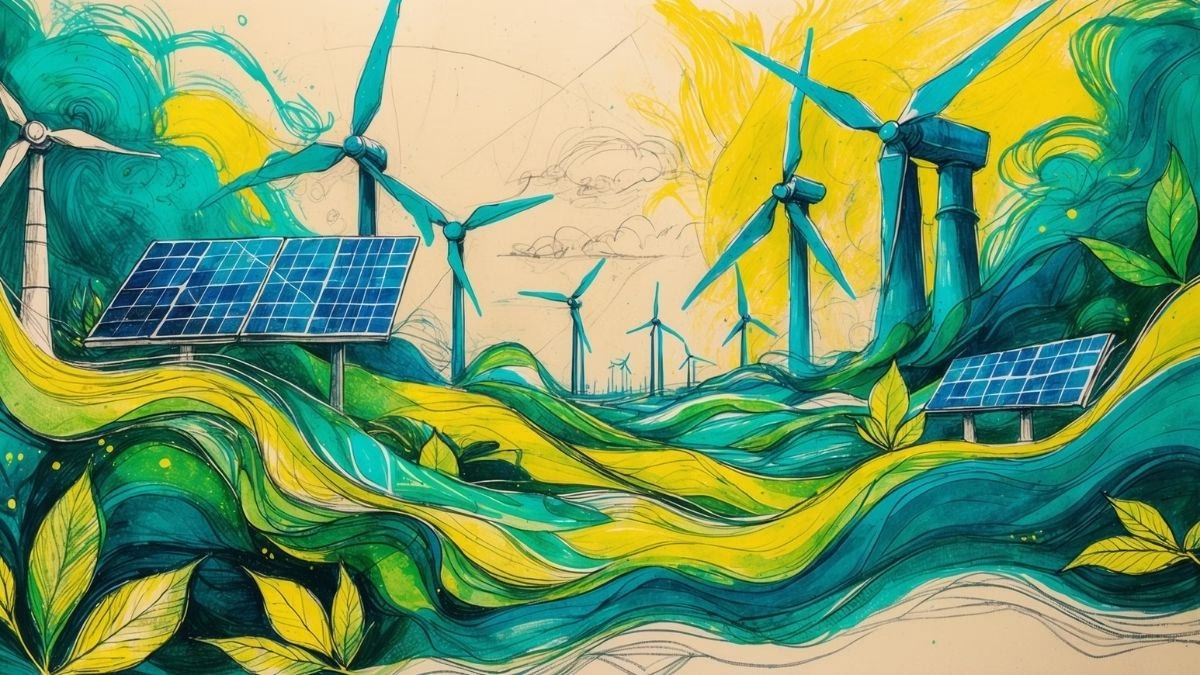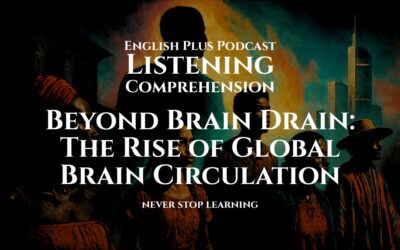Power Up Your Listening: Renewable Energy Breakthroughs
Welcome! Today’s listening practice will focus on a scientific topic: renewable energy. Passages like this are common in exams like TOEFL and IELTS and test your ability to understand technical explanations, comparisons, and discussions of advantages and disadvantages.
Here are some pro tips for tackling scientific and technical content:
- Don’t Panic at Technical Terms: You will hear words like “photovoltaic” or “electrolysis.” Often, the speaker will provide a brief explanation. Your job is to understand the function and purpose of the technology being described, not to become an expert physicist.
- Listen for Problem/Solution Structures: Scientific lectures often present a problem (e.g., the intermittency of solar power) and then discuss potential solutions (e.g., breakthroughs in energy storage). Identifying this structure helps you organize the information.
- Categorize Information: The speaker will likely discuss several different types of renewable energy. Use your notes to create categories (e.g., Solar, Geothermal, Hydrogen) and list the key details for each one.
- Focus on Relationships: Pay attention to comparative words (“more efficient,” “less expensive,” “unlike solar…”). These words are crucial for understanding the pros and cons of each technology.
You will now listen to a speaker at a conference on innovations in technology.
Listen
Transcript
Listening Transcript: Please do not read the transcript before you listen and take the listening comprehension quiz.
Good morning, everyone. For decades, the conversation around renewable energy has been dominated by two familiar giants: solar and wind. And for good reason. The plummeting costs and increasing efficiency of solar photovoltaic panels and wind turbines have been one of the greatest technological success stories of our time. But to achieve a truly comprehensive and resilient green energy system, we need to look beyond these two pillars. Today, I want to shine a light on some of the most exciting breakthroughs happening in other areas of renewable energy—innovations that are poised to solve some of the sector’s most persistent challenges.
The first and perhaps most significant challenge is intermittency. The sun doesn’t always shine, and the wind doesn’t always blow. This variability is a major headache for grid operators who need a constant, reliable supply of power. The holy grail, therefore, is effective and affordable energy storage. While lithium-ion batteries, the kind in your phone and electric car, are the current market leaders, we’re seeing incredible progress in alternatives. I want to highlight two: flow batteries and solid-state batteries.
Flow batteries are fascinating. Unlike a conventional battery where all the components are in one solid package, a flow battery stores its energy in external tanks of liquid electrolyte. To generate power, you simply pump the liquids through a central stack. The key advantage here is scalability. To get more energy, you don’t need to build a whole new battery; you just need bigger tanks of liquid. This makes them potentially much cheaper and more durable for large-scale, long-duration storage—exactly what the grid needs to store solar energy generated during the day to use at night.
On the other end of the spectrum are solid-state batteries. These replace the liquid electrolyte in conventional batteries with a solid material. This breakthrough could lead to batteries that are not only safer—as the liquid in lithium-ion batteries is flammable—but also more energy-dense, meaning they can store more energy in a smaller space. While their initial application will likely be in electric vehicles, their development is crucial for the entire energy storage ecosystem.
Now, let’s move from storing energy to generating it in new ways. Let’s talk about the earth itself as a battery: geothermal energy. Traditional geothermal power plants are limited to specific geographic locations with natural hot springs or geysers. But a new approach called Enhanced Geothermal Systems, or EGS, is a game-changer. EGS involves drilling deep into the earth—two to three kilometers down—and then fracturing the hot, dry rock. Water is then pumped down one well, circulates through the fractures absorbing heat, and then returns to the surface as superheated water or steam, which then drives a turbine. The beauty of EGS is that it could theoretically be deployed almost anywhere, transforming geothermal from a niche player into a mainstream source of constant, 24/7 renewable power.
Another area brimming with innovation is green hydrogen. Hydrogen is the most abundant element in the universe, and it’s a fantastic energy carrier. The challenge has always been producing it without fossil fuels. Currently, most hydrogen is produced from natural gas, a process that releases carbon dioxide. Green hydrogen, however, is produced using a process called electrolysis, where renewable electricity—from solar or wind, for instance—is used to split water into hydrogen and oxygen. This process yields a completely carbon-free fuel. This green hydrogen can be stored for long periods, transported, and used in fuel cells to generate electricity, or used as a clean fuel for heavy industry and transportation, like shipping and trucking, which are notoriously difficult to decarbonize.
Finally, even in the familiar field of solar, the innovation isn’t standing still. While silicon-based panels are the standard, a new class of materials called perovskites is causing a huge amount of excitement. Perovskite solar cells can be manufactured more cheaply and with less energy than silicon cells. They can be flexible, lightweight, and even transparent, opening up possibilities like windows that generate electricity. Their main challenge so far has been durability; they tend to degrade when exposed to moisture and air. However, recent breakthroughs in protective coatings and material stability are rapidly overcoming these issues. Many scientists believe the future of solar lies in tandem cells, which stack a perovskite cell on top of a silicon cell, allowing the device to capture different wavelengths of light and dramatically boost overall efficiency.
In conclusion, while we should continue to celebrate and deploy wind and solar, the next chapter in the renewable energy story will be written by these diverse and complementary technologies. From advanced batteries that provide stability, to deep geothermal that offers constant power, and green hydrogen that can clean up heavy industry, these breakthroughs are collectively building a more robust, reliable, and ultimately 100% renewable energy system for the future. Thank you.
Listening Comprehension Quiz
Key Vocabulary and Phrases
- Intermittency:
- What it means: The quality of occurring at irregular intervals; not continuous or steady.
- How it was used: The speaker used this to describe the main problem with solar and wind power: they don’t generate electricity all the time, creating a challenge for the power grid.
- Holy Grail:
- What it means: A thing that is being eagerly sought after but is very difficult to find or obtain.
- How it was used: The speaker referred to “effective and affordable energy storage” as the “holy grail” for renewables, meaning it’s the ultimate, highly sought-after solution.
- Scalability:
- What it means: The capacity to be changed in size or scale. In technology, it means a system’s ability to handle a growing amount of work by adding resources.
- How it was used: This was highlighted as the key advantage of flow batteries, as their storage capacity can be easily increased by making their liquid tanks larger.
- Energy-Dense:
- What it means: Having a high amount of energy stored in a small amount of mass or volume.
- How it was used: Solid-state batteries were described as being more “energy-dense,” meaning they can hold more power in a smaller, lighter package.
- Geothermal Energy:
- What it means: Thermal energy generated and stored in the Earth.
- How it was used: The lecture discussed traditional geothermal and Enhanced Geothermal Systems (EGS) as a source of constant, 24/7 renewable power.
- Niche Player:
- What it means: A company or product that serves a small, specific part of the market.
- How it was used: The speaker said EGS could transform geothermal from a “niche player” (a minor source of energy) into a “mainstream source.”
- Green Hydrogen:
- What it means: Hydrogen produced through a process (like electrolysis) that is powered by renewable energy sources, resulting in zero carbon emissions.
- How it was used: This was presented as a clean fuel breakthrough, distinct from hydrogen produced using fossil fuels.
- Electrolysis:
- What it means: A process that uses a direct electric current to drive an otherwise non-spontaneous chemical reaction.
- How it was used: The lecture explained this is the process used to create green hydrogen, where electricity splits water into hydrogen and oxygen.
- Decarbonize:
- What it means: To reduce or eliminate carbon dioxide emissions from a process or an entire economy.
- How it was used: The speaker noted that sectors like shipping and trucking are “notoriously difficult to decarbonize,” and that green hydrogen offers a solution.
- Tandem Cells:
- What it means: A type of solar cell that combines two or more different materials to capture a wider range of the light spectrum, increasing overall efficiency.
- How it was used: The lecture described a promising future for solar in “tandem cells” that stack perovskite and silicon materials together.










0 Comments